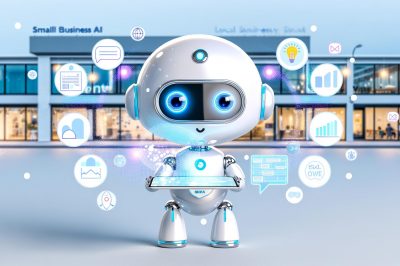Understanding the Basics of AI Automation

Table of Contents
- Understanding the Basics of AI Automation
- Time-Saving Strategies with AI Tools
- Boosting Engagement: AI-Driven Content Strategies
- AI Trends to Watch in 2024
- Avoiding Common Pitfalls in AI Social Media Automation
- Myth-Busting: Debunking AI Automation Fears
- Increasing ROI with AI Analytics
- Personalising Customer Experience with AI
- Balancing Automation with Human Touch
- The Ethical Side of AI in Marketing
Introduction
Discover how AI-driven social media automation can transform the marketing efforts of small businesses in Swansea, enabling growth, increasing client engagement, and optimising time management.
Understanding the Basics of AI Automation
Time-Saving Strategies with AI Tools
For small businesses in Swansea, managing social media can be a daunting task, yet AI tools have emerged as powerful allies, streamlining processes and saving valuable time. These tools can automate numerous activities associated with social media management, such as content scheduling and customer interactions, which is particularly beneficial for businesses with limited resources.
One of the primary advantages of using AI tools is the ability to automate content scheduling. For instance, tools like Sprout Social and Buffer allow small businesses to plan their posts in advance, ensuring that content goes live at optimal times without the need for constant manual input. This automation helps maintain a consistent online presence, critical for audience engagement. Businesses can create a month’s worth of posts in one go, freeing up their schedules for other essential tasks.
Another area where AI tools significantly enhance efficiency is in customer interaction. AI-driven chatbots can manage initial customer inquiries, providing instant responses to frequently asked questions. Platforms like Ocoya integrate content creation with social listening capabilities, allowing businesses to respond promptly to customer feedback and trends while spending less time online.
Moreover, features such as sentiment analysis can provide insights into customer feelings regarding products or services, giving small business owners data to refine their strategies without sifting through countless comments and messages manually.
In essence, leveraging these AI tools equips small businesses not only to save time but also to engage effectively with customers and enhance their social media strategies.
Time-Saving Strategies with AI Tools
Customer Engagement Automation
AI chatbots enable 24/7 support, instant responses, and transaction management. For example, a Swansea café might use chatbots to handle menu inquiries or a boutique to check clothing stock, boosting customer satisfaction and freeing staff for strategic tasks. Tools like Botsify or Adcreative.AI can streamline interactions without human intervention.
Predictive Analytics & Demand Forecasting
AI analyses customer behaviour to identify trends, optimise inventory, and reduce waste. Tools like Pecan AI or IBM Watson Studio enable small businesses to:
- Anticipate seasonal sales (e.g., holiday promotions)
- Target at-risk customers with personalised retention campaigns
- Analyse competitor strategies to refine marketing approaches
AI-Driven SEO & Content Marketing
AI-powered SEO strategies accelerate results by:
- Identifying high-performing keywords in real-time
- Optimising content for superior search rankings
- Analysing competitor gaps to outrank larger businesses
Tools like Jasper (content creation) and Semrush (SEO analytics) help Swansea businesses achieve faster, cost-effective visibility.
Optimised Google Ads & Social Media
AI ad platforms like Adcreative.AI generate tailored ad creatives and test multiple iterations to maximise ROI. Key benefits include:
- Precision targeting of Swansea demographics
- Automated bid adjustments to reduce cost-per-acquisition
- Increased conversion rates through data-driven ad copy
Case studies show businesses doubling click-through rates with AI-designed ads.
Lead Generation & Follow-Up Automation
AI tools like HubSync and HubSpot automate lead scoring, nurturing, and follow-ups via:
- Personalised email/SMS sequences
- AI-assisted voice calls for high-value leads
- 24/7 chatbot responses to new inquiries
A Swansea roofing company reported a 65% increase in customer response rates using automated follow-ups.
Implementation Steps
- Audit workflows to identify repetitive tasks (e.g., social media management, data entry).
- Adopt scalable tools like Lately.ai for content automation or HubSpot CRM for lead tracking.
- Train staff on AI platforms to ensure smooth integration.
- Pilot projects (e.g., chatbot trials) to measure ROI before full adoption.
Boosting Engagement: AI-Driven Content Strategies
AI Trends in Social Media Marketing for Small Businesses in 2024
As we look ahead to 2024, several key trends are poised to shape the landscape of social media marketing for small businesses. Understanding these trends can provide significant advantages, especially as more business owners in Swansea seek innovative ways to enhance their marketing strategies through AI.
Generative AI Adoption
Generative AI is becoming essential for small businesses, particularly in content creation. Tools such as ChatGPT, Copy.ai, and Canva’s Magic Studio streamline processes by automating tasks like caption writing and image generation. This capability allows businesses to produce content at a much higher volume, which is crucial for maintaining an active online presence. Notably, over 48% of small businesses reported adopting AI tools as of 2023, highlighting the efficiency and scalability these platforms provide.
Strategic AI Integration
AI is evolving into a strategic partner for small businesses by aiding in predictive analytics and campaign optimisation. Tools like Dash Social and Sprout Social forecast high-performing content and help refine audience targeting. Marketers are leveraging AI to produce insightful reports, allowing them to make data-driven decisions swiftly and effectively.
AI-Powered Efficiency Tools
Small businesses are increasingly adopting specialised AI tools for various functions:
- Content Recycling: Tools like FeedHive automatically repurpose and repost content, ensuring maximum reach.
- Channel-Specific Optimisation: Buffer customises posts for different platforms, tailoring content for Instagram versus TikTok.
- Automated Support: AI chatbots provide 24/7 customer service, significantly reducing the workload for small business teams.
Personalisation & Predictive Analytics
AI facilitates hyper-personalised marketing campaigns by analysing user behaviour and preferences. Predictive analytics tools allow small businesses to optimally manage inventory, tailor influencer collaborations, and refine product recommendations. For example, TikTok Shop employs AI to connect products with a user’s interests, enhancing shop conversions through targeted promotions.
Ethical & Practical Considerations
While AI introduces remarkable efficiencies, small businesses must remain vigilant in maintaining authenticity. Balancing automation with a human touch is vital. Ensuring compliance with ethical standards—such as avoiding deepfakes or misleading advertisements—will enhance brand credibility. Notably, campaigns that feature user-generated content resonate with consumers, as 83% prefer brands that highlight real customer experiences.
AI Trends to Watch in 2024
Small businesses often struggle with effective AI implementation in social media marketing due to common pitfalls that hinder ROI and engagement. Here’s a breakdown of key mistakes and strategies to avoid them:
Strategic Missteps
- Overestimating AI Capabilities
- Mistake: Treating AI as a magic solution that automates creativity or guarantees overnight success.
- Reality: AI excels at optimising ads, personalising content, and predicting trends, but lacks human intuition for emotional resonance or nuanced storytelling.
- Solution: Pair AI-generated content with human oversight to refine messaging and ensure brand consistency.
- Lack of Strategy
- Mistake: Adopting AI tools without aligning them to clear business goals.
- Impact: Wasted resources, misaligned campaigns, and suboptimal ROI.
- Solution: Develop a tailored strategy focused on specific use cases (e.g., audience segmentation, ad targeting) and integrate AI gradually into existing workflows.
Technical and Operational Errors
- Neglecting Data Quality
- Mistake: Using incomplete, outdated, or irrelevant data for AI systems.
- Risk: Inaccurate predictions, ineffective personalisation, and skewed analytics.
- Solution: Prioritise clean, high-volume data and regularly audit inputs for accuracy.
- Overdependence on Automation
- Mistake: Relying solely on AI for repetitive tasks (e.g., chatbots, email campaigns).
- Consequence: Impersonal interactions and missed opportunities for genuine engagement.
- Solution: Use AI to augment, not replace, human effort. Review AI outputs for context and adjust as needed.
- Ignoring Skills Gaps
- Mistake: Lack of in-house expertise to manage AI tools effectively.
- Result: Underutilised tools and poor interpretation of analytics.
- Solution: Train staff to interpret AI insights and partner with specialists when needed.
Content and Audience-Related Errors
- Generic Content Across Platforms
- Mistake: Posting identical content on all social channels.
- Issue: Misalignment with platform-specific audiences (e.g., LinkedIn vs. Instagram).
- Solution: Tailor content formats and messaging to match audience preferences on each platform.
- Failing to Personalise
- Mistake: Using one-size-fits-all campaigns instead of leveraging AI for hyper-targeted messaging.
- Impact: Lower engagement and conversions.
- Solution: Use AI to analyse customer behaviour and craft dynamic, individualised campaigns.
- Vague Instructions to AI
- Mistake: Providing unclear prompts for content generation.
- Result: Irrelevant or tone-deaf outputs.
- Solution: Use specific, structured prompts and review AI-generated content for alignment with brand voice.
Engagement and Analytics Mistakes
- Neglecting Audience Interaction
- Mistake: Failing to respond to comments, engage in conversations, or leverage user-generated content.
- Consequence: Low algorithmic reach and weakened brand loyalty.
- Solution: Allocate time to reply to feedback and participate in community-driven discussions.
- Overlooking Performance Analysis
- Mistake: Posting content without tracking engagement metrics.
- Impact: Inefficient spending and stagnant growth.
- Solution: Regularly audit post performance to refine strategies and optimise timing.
Key Takeaways
- Balance AI and Human Insight: Use AI for efficiency (e.g., analytics, scheduling) but retain human creativity and empathy.
- Audit and Adapt: Continuously review data quality, campaign performance, and audience preferences.
- Platform-Specific Strategy: Tailor content to each social channel’s unique audience and format.
By addressing these errors, small businesses can harness AI to amplify, rather than replace, their marketing efforts.
Avoiding Common Pitfalls in AI Social Media Automation
Small business owners often harbour fears and misconceptions about AI automation, which can lead to hesitation in adopting this transformative technology. By understanding and debunking these myths, businesses in Swansea can harness AI effectively and enhance their operational efficiency and customer engagement.
Myth 1: AI Replaces Human Jobs
Fear: There is a widespread belief that AI will take over jobs, rendering human roles in customer support and operations obsolete.
Reality: In fact, AI primarily automates repetitive tasks, allowing employees to focus on strategic and creative areas that require human intuition and emotional intelligence. For example, while AI-powered chatbots handle standard inquiries, they enable your team to address more complex customer needs, enhancing the overall service experience.
Myth 2: AI Is Only for Big Businesses
Fear: Many small business owners believe they lack the resources to engage with AI technologies.
Reality: The market now offers affordable, cloud-based tools, making AI accessible to businesses of all sizes. Solutions like CRM platforms with built-in AI capabilities allow SMBs to automate tasks and gain valuable insights without significant investment.
Myth 3: AI Is Too Complex or Expensive
Fear: Some perceive AI adoption as requiring advanced technical skills or substantial financial outlay.
Reality: User-friendly AI solutions exist that require minimal technical knowledge. Many tools follow subscription models, enabling small businesses to integrate AI gradually and manage costs effectively.
Myth 4: AI Requires Massive Data Sets
Fear: Small businesses often think they don’t have enough data for AI to be effective.
Reality: AI can still derive insights from smaller datasets. Initial data inputs can progressively improve AI accuracy as businesses gather more information over time, thus refining strategies.
Myth 5: AI Compromises Security and Privacy
Fear: Concerns over data security risks related to AI usage are common.
Reality: Responsible AI implementation incorporates stringent security measures, such as encryption and data compliance protocols, protecting sensitive information while utilising AI effectively.
Myth-Busting: Debunking AI Automation Fears
AI Analytics Tools for Small Business Marketing ROI
To maximise Return on Investment (ROI) in marketing, small businesses can leverage AI-powered analytics tools that streamline data analysis, optimise campaigns, and drive actionable insights. Below is a curated list of tools organised by their core functionalities:
1. Content Optimisation & SEO
- MarketMuse: Uses AI to analyse and optimise website content for SEO, improving search engine rankings and driving organic traffic.
- Jasper: Generates marketing copy (social media posts, emails, blogs) with tone and SEO integration, reducing content creation time and enhancing search visibility.
- Grammarly: Ensures error-free, engaging content across platforms, boosting credibility and customer trust.
2. Ad Campaign Performance
- Trellis: Optimises e-commerce ad campaigns by adjusting keyword bids, testing pricing strategies, and analysing trends to maximise ROI.
- Adzooma: Automates Google Ads, Facebook Ads, and SEO campaigns, reducing manual effort and improving ad spend efficiency.
- Funnel.io: Consolidates data from 500+ sources to analyse ad performance and prioritise high-ROI channels.
3. Customer Insights & Behaviour Analysis
- Brand24: Monitors social media mentions and sentiment in real-time, helping businesses address customer concerns and protect brand reputation.
- Crayon: Analyses competitors’ marketing strategies, enabling small businesses to identify gaps and adjust tactics for competitive ROI.
- AnswerRocket: Allows natural-language queries to analyse customer data without requiring technical expertise, accelerating decision-making.
4. CRM & Workflow Automation
- Pipedrive: Provides AI-driven lead scoring, email summarisation, and deal prediction to prioritise high-value leads and streamline sales pipelines.
- Zapier: Automates workflows across apps, freeing time for strategic activities that drive revenue.
5. Social Media & Engagement Analytics
- Buffer: Schedules and analyses social media posts to optimise reach and engagement.
- Oribi: Focused on LinkedIn analytics, tracks conversions and social ad ROI, ideal for B2B businesses.
Key Metrics Tools Track for ROI
| Metric | Tool Example | Impact on ROI |
|---|---|---|
| CAC | Funnel.io, Crayon | Reduces acquisition costs by streamlining campaigns |
| Conversion Rate | MarketMuse, Trellis | Improves sales from organic traffic and ad targeting |
| Engagement Rate | Buffer, Brand24 | Boosts brand loyalty and organic reach |
| CLV | AnswerRocket, Pipedrive | Identifies high-value customers for upselling |
Pricing Considerations
- Affordable Options: Zapier (free plan), Buffer (£6/month), Pipedrive (£14/month).
- Mid-Range: Trellis (£299–£1,499/month), Brand24 (£99–£179/month).
- Enterprise-Ready: HubSpot Marketing Hub (paid plans from £18/month), Julius AI (custom pricing).
By deploying these tools strategically, small businesses can automate repetitive tasks, refine targeting, and derive actionable insights to allocate budgets effectively.
Increasing ROI with AI Analytics
Hyper-Personalised Marketing Strategies
AI enables Swansea businesses to craft customer-specific campaigns using data insights. For example, predictive models can analyse purchasing behaviour to forecast needs, allowing businesses like local boutiques to suggest products via chatbots or personalised email sequences. Tools such as HubSync prioritise high-value leads by scoring them based on intent and interactions, thereby reducing wasted resources on unqualified prospects.
24/7 Customer Service Automation
AI chatbots empower Swansea businesses to deliver round-the-clock support without straining staff. A local café, for instance, employs chatbots to manage reservations, answer FAQs, and handle simple transactions, thus freeing employees to focus on in-person customer service. These chatbots can reduce response times by up to 50%, significantly improving customer satisfaction rates while lowering operational costs.
Predictive Analytics for Targeted Outreach
AI facilitates the analysis of historical data to identify customer segments that are most likely to convert, enabling Swansea businesses to refine their marketing efforts effectively. A notable case involves a roofing company in the area that experienced a 65% increase in customer response rates by implementing AI-driven automated follow-ups such as emails and SMS reminders. Additionally, AI-powered ad platforms like Google Ads can optimise spend by adjusting bids in real-time, leading to a 20% reduction in cost-per-acquisition (CPA) compared to manual methods.
Addressing Adoption Barriers
Despite some small businesses hesitating due to budget constraints or technical complexities, affordable cloud-based solutions and local partnerships can help mitigate these challenges. Firms like Omni Marketing offer tailored AI assistants that automate social media scheduling, customer follow-ups, and content optimisation without necessitating in-house expertise. Moreover, platforms like Jasper.ai streamline SEO-optimised content creation, ensuring local visibility on Google and social platforms.
Personalising Customer Experience with AI
Maintaining a human touch in social media automation is critical for small businesses to build trust, foster engagement, and sustain brand authenticity. Here’s why it matters and how to balance automation with personal connection:
Time Efficiency Meets Authenticity
Automation handles repetitive tasks like scheduling posts, curating content, and analysing performance metrics, freeing up time for strategic, human-driven activities. However, over-reliance on automation risks making interactions feel impersonal. For example:
- Scheduling posts at optimal times boosts reach but requires reviewing drafts to ensure quality.
- Analytics tools can track engagement rates but must be complemented by manual review to capture finer details.
Key Takeaway: Automate workflows but prioritise human oversight for content quality and strategic direction.
Personalisation and Trust
Audiences crave personalised interactions. While automation can segment audiences or use data to address users by name, it’s imperative to:
- Avoid generic responses in comments or DMs. Instead, pair automated prompts with genuine human follow-ups.
- Tailor DM campaigns to deliver warm, branded messages rather than robotic responses.
Example: Automated tools can trigger a “thank you” message for a review, but a human should craft a heartfelt reply to deepen the relationship.
Human-Driven Engagement Strategies
True social media success hinges on real-time, human interaction:
- Respond to comments and DMs manually to address concerns authentically.
- Use humour or creative content (e.g., memes, behind-the-scenes stories) to build relatability.
- Leverage employee advocacy by encouraging staff to share brand updates, fostering organic reach and authenticity.
Pro Tip: Automate the “start” of conversations (e.g., sharing content) but handle the “follow-through” personally.
Maintaining Brand Consistency
Automation tools help ensure consistent posting schedules and messaging, but brand voice must remain human-centric:
- Draft and review posts in advance to edit tone and ensure alignment with values.
- Avoid overly mechanical phrasing in automated messages. Use templates with placeholders for personalisation.
Why It Matters: Consistent yet warm messaging builds recognition without sacrificing the “social” in social media.
Employee Advocacy and Community Building
Small businesses thrive when employees become brand ambassadors:
- Educate team members on social media best practices to encourage organic sharing.
- Highlight team stories or customer testimonials in posts to humanise the brand.
Case Study: A B2B company like beehiiv uses humour and employee-led videos to connect with audiences while maintaining professionalism.
By blending automation with intentional human effort, small businesses can scale their social media presence without sacrificing the personal connections that drive loyalty. The key is to use tools to enhance—not replace—the irreplaceable human element.
Balancing Automation with Human Touch
Data Privacy Challenges
AI-driven social media marketing in 2025 faces heightened scrutiny over data collection practices. While AI personalises content by analysing user behaviour, brands must comply with regulations like GDPR and CCPA, ensuring transparency in data usage. Overly intrusive data collection risks consumer trust, especially as users increasingly question how their information is leveraged.
Transparency Demands
Consumers expect clarity about AI usage. Key strategies include:
- Explicit disclosure for AI-generated content (e.g., labelling images/videos as “AI-created”).
- Clear data control options, such as allowing users to block tracking or opt out of targeted ads.
- Auditable decision-making to prevent biased outcomes in ad delivery, as seen in cases of skewed job/mortgage promotions.
Bias Mitigation Efforts
Unchecked AI biases, often rooted in training data, can perpetuate stereotypes or exclusionary marketing. Solutions include:
- Regular algorithm audits to identify and correct discriminatory patterns.
- Diverse training datasets to ensure equitable representation and avoid inadvertent discrimination.
Balancing Automation and Authenticity
While AI excels at automating tasks like scheduling and analytics, human creativity remains crucial:
- Hybrid approaches combine AI efficiency with human storytelling to avoid robotic interactions.
- Social proof strategies, such as verified client testimonials or Google Business Profile reviews, counterbalance AI-generated content scepticism.
Platform Ecosystem Risks
Meta’s shift toward unmoderated platforms raises ethical concerns about content adjacency. Brands must proactively:
- Differentiating authentic content through high-quality, verifiable results to counter misinformation.
- Exploring alternative platforms (e.g., Mastodon) to diversify reach and reduce dependency on volatile ecosystems.
As AI integration deepens, ethical compliance is not optional—it’s foundational to sustaining consumer trust in an increasingly complex digital landscape.
The Ethical Side of AI in Marketing
AI marketing tools are transforming how small businesses in Swansea operate, offering tailored solutions to compete in a dynamic local economy. By automating tasks, enhancing customer engagement, and leveraging data analytics, these tools provide cost-effective strategies for growth.
Key Strategies for Swansea Businesses
1. Content and Workflow Automation
AI tools streamline content creation and repetitive tasks:
- Jasper.ai and Copy.ai generate social media posts, blog content, and email campaigns quickly.
- Narrato and Pictory accelerate production of multimedia content like videos.
- HubSpot manages cross-platform social media campaigns while maintaining brand consistency.
2. Customer Engagement and Service
- Chatbots: provide 24/7 customer support, resolving queries instantly (e.g., café menu inquiries or boutique stock checks).
- Personalisation tools: tailor recommendations to customer preferences, improving satisfaction and retention.
3. Predictive Analytics and Targeting
- Demand forecasting: uses tools like HubSync or Pecan AI to anticipate seasonal sales and optimise inventory management.
- Customer segmentation and churn reduction: powered by IBM Watson Studio, identifying at-risk clients and targeting retention campaigns.
Benefits for Swansea SMEs
- Efficiency: Automation reduces manual workloads by up to 40%, freeing staff for strategic tasks.
- Cost Savings: AI-driven ad bidding (e.g., AdCreative.AI) lowers acquisition costs by 20% compared to manual approaches.
- Data-Driven Decisions: Predictive tools analyse customer behaviour to refine marketing strategies.
Implementation Steps
- Audit Workflows: Identify repetitive tasks (e.g., social media management, email follow-ups).
- Choose Scalable Tools: Opt for platforms like Omni Marketing’s AI Assistants or HubSpot for integration and growth.
- Train Teams: Ensure staff are comfortable using tools like chatbots or analytics platforms.
- Pilot Projects: Test AI solutions (e.g., automated lead follow-ups) to measure ROI before full implementation.
Top Tools for Swansea Businesses
| Task | Tools | Outcome |
|---|---|---|
| Content Creation | Jasper.ai, Copy.ai, Narrato | Faster writing, consistent output. |
| Ad Optimisation | AdCreative.AI | Higher CTR, platform-specific designs. |
| Lead Generation | HubSync, Pecan AI | Targeted campaigns, reduced churn. |
| Social Media Management | HubSpot, Missinglettr | Automated drip campaigns, analytics. |
By adopting AI strategies, Swansea businesses can enhance operational efficiency, improve customer experiences, and drive sustainable growth in a competitive market.
Sources
- Sprout Social – How AI Can Transform Social Media Management
- Buffer – The Best Social Media Management Tools for Businesses
- Ocoya – AI-Powered Social Media Management
- Omni Marketing – How Can Swansea Businesses Boost Marketing with AI?
- Omni Marketing – How Can Swansea Businesses Boost Growth with AI?
- Anton Koekemoer – How AI Marketing Can Transform Small Businesses
- Homebase – AI for Small Business Marketing
- Kopa Marketing – AI-Powered Lead Generation: Transforming Small Business Growth in Wales
- Affordable Marketing Solutions: The Swansea Small Business Growth Plan Under £500/Month – 15 May 2025
- AI in Accounting Marketing: Leveraging Technology for Client Acquisition – 15 May 2025
- The Essential Legal Content Management System: Organize Your Thought Leadership for Maximum Impact – 14 May 2025






